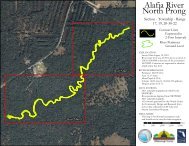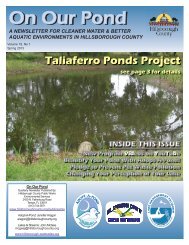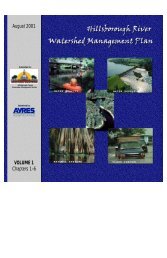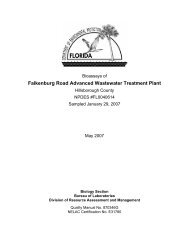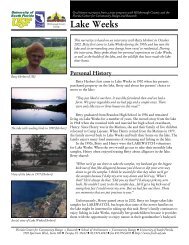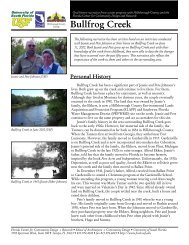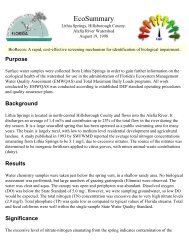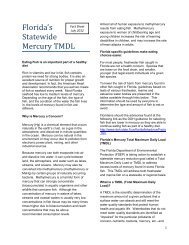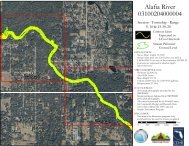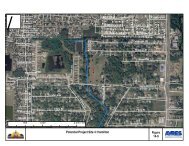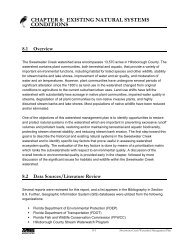Rocky Brushy Creek Watershed Mgmt. Plan (2007) -- Part 2
Rocky Brushy Creek Watershed Mgmt. Plan (2007) -- Part 2
Rocky Brushy Creek Watershed Mgmt. Plan (2007) -- Part 2
You also want an ePaper? Increase the reach of your titles
YUMPU automatically turns print PDFs into web optimized ePapers that Google loves.
EXISTING NATURAL SYSTEMS CONDITIONSconstructed numerous underpasses for black bears, Pinellas County has constructed fish bridgesallowing fish migration through weirs, and the City of Clearwater has constructed a wildlife bridgeacross a fast flowing channel, allowing small mammals to cross.Criteria for significant wildlife habitat minimum widths and sizes are contained in Appendix B of theHillsborough County Natural Resources Regulation. Existing studies have established a definitivelink between habitat area size and species diversity (Miller and Schaeffer, 1998). The HillsboroughCounty Natural Resources Regulation sets a 75-acre minimum based on wildlife research reviewthat concluded that species diversity rapidly declines below 60 acres, while another studydetermined 50 to 74 acres as the optimum minimum habitat. Although wildlife corridors do not haveto follow these criteria for size and width, reserving 75 acres or more of significant wildlife habitatshould be taken into consideration as core habitat or as the basis for a wildlife corridor.Although wildlife corridors can help conserve habitat dependent species affected by encroachingurbanization, it is important to consider that the total amount of available habitat is the critical factorand that no amount of corridors connecting isolated habitat areas will replace extensive loss ofhabitat. Wildlife corridors allow for the linkage and preservation of isolated wildlife habitats in thecompetition for space with humans.8.5.3 Identification of Existing Riparian Buffer AreasMeasures of ecosystem health can play an important role in the linkage between land usepractices, ecological integrity, and water quality. The loss of natural riparian vegetation due toagriculture and development impair the functional role of riparian buffers, strongly influencing thediversity and productivity of both the aquatic and terrestrial biota, and the physical stability of thestreambank and channel. A critical component of the riverine ecosystem, riparian buffers functionecologically to:• regulate sediment storage and transport,stream flow characteristics;• maintain bank and channel stability byprovision of solid root mass and groundcover, regulate stream temperature;• regulate instream biological productionby determining the inputs of smallorganic debris (SOD);• buffer streams from fine sediments;• provide wildlife habitat features,including coarse woody debris (CWD),large woody debris (LWD), and nest andperch sites; and• provide summer and winter forage for terrestrial fauna.8-24<strong>Rocky</strong>/<strong>Brushy</strong> <strong>Creek</strong> <strong>Watershed</strong> Management <strong>Plan</strong>



